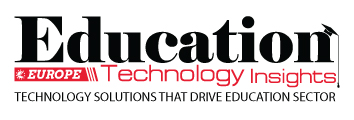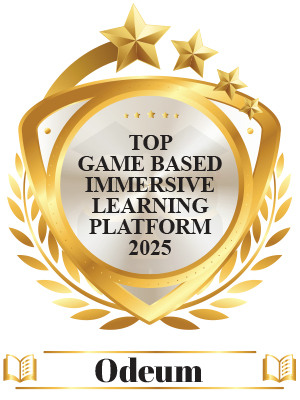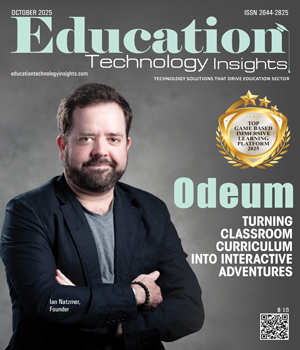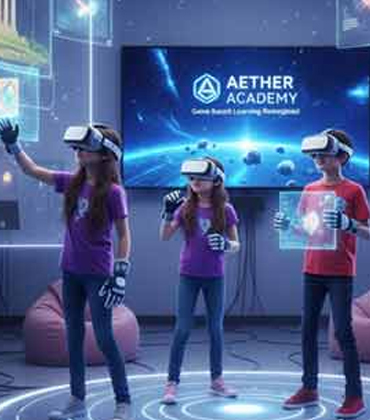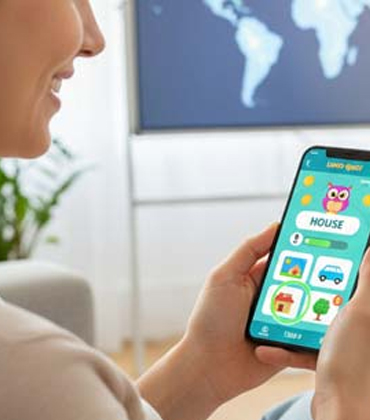THANK YOU FOR SUBSCRIBING
Be first to read the latest tech news, Industry Leader's Insights, and CIO interviews of medium and large enterprises exclusively from Education Technology Insights
Most attempts at game-based learning are like chocolate-covered broccoli. The game and the lesson are in tandem, one posed as a prize for completing the other. Students grind through a worksheet, then earn a few minutes of unrelated gameplay. The chocolate hides the broccoli, but the two never truly mix. Learning remains work. James Paul Gee, a prominent linguist and education researcher at Arizona State University, argued that the true potential of game-based learning lies in dissolving that divide. When play and pedagogy are woven together, the game becomes the act of learning. Every quest, challenge and decision pulls the student deeper into the material. Odeum, an edtech company specializing in game-based, immersive learning, makes this goal a reality. It builds curriculum-aligned adventures where the lesson becomes the game. Students are drawn into a story where every choice, conversation and quest directly ties to learning objectives. A Mandarin lesson transforms into a quest where practicing sentence patterns unlocks new dialogue and story paths. A history unit becomes an unfolding drama where understanding the Stamp Act of 1765 determines what happens next. “If you hand a student a worksheet, they’ll ask how many problems they have to finish. If you place that same objective inside a story, they’ll ask what happens next. That shift makes learning stick,” says Ian Natzmer, founder of Odeum. When Teachers Become World Builders Most edtech platforms force educators to choose between engaging but rigid content and customizable tools that demand technical expertise they don’t have. Odeum eliminates the trade-off by giving teachers creative control. They become world builders, turning lessons into immersive experiences where every practice session advances a meaningful story. Routine drills become an adventure that students want to complete, while educators retain complete control over how learning unfolds. Powering this shift is Odeum Studio, an AI-driven authoring tool that makes game creation as natural as writing a lesson plan. Teachers enter their learning goals, like mastering a grammar rule, explaining a scientific principle or unpacking a historical event and add as much creative input as they want. The studio generates storylines, characters and dialogue options aligned to those objectives. Educators can approve drafts as is or refine them until the experience matches their classroom vision. What would usually take weeks of design and technical work is accomplished in minutes. Every lesson built in Odeum Studio becomes part of a growing digital library of reusable, adaptable adventures. “We’re building a digital library, not just games,” says Natzmer. “As teachers create experiences with Odeum, those games can be shared and reused. This flexibility saves time and every classroom can have its customized adventure.” Once built, the experiences are delivered through Odeum, which is platform-agnostic by design. Games can be deployed wherever students are, on web browsers, in 3D virtual worlds and on mobile devices. Removing technical barriers ensures learning can happen seamlessly across environments.
Top Social Emotional Learning Curriculum and Regulation Program Providers 2025
After recess, a student returns to the classroom with a tense posture, quick breathing, and a searching gaze. Perhaps a lively game, loud noise, or extra stimulation has left them feeling heightened. In this moment, they need time to settle before they can fully engage in learning. Scenes like this unfold every day in classrooms. What is often mistaken for misbehavior is actually a struggle to manage emotions, without the skills to handle big feelings, regulate energy levels, and refocus. Emotional regulation is not something children develop on their own. Like reading or problem-solving, it is a skill that requires nurturing. That is where The Zones of Regulation gives students a way to understand their emotions and take action. Through a simple, color-based system, learners recognize how they are feeling, build strategies that support their needs, and regulate to a state where learning is possible. It turns feelings into something students can name, talk about, and manage with the support of the adults around them. “We are all working on regulation. It is a skill that we develop over the course of our lifetime. What is distinct about The Zones of Regulation is that we empower learners of all ages to understand their full range of feelings and explore meaningful tools and strategies to support their well-being,” says Leah Kuypers, founder and CEO. While working as an occupational therapist and autism resource specialist in public schools, Kuypers saw the need for a practical way to teach emotional self-regulation, sparking the creation of The Zones of Regulation. It equips students with a framework of four color-coded zones that represent different states of alertness and emotions. Blue signals low energy, such as sadness or fatigue. Green reflects a calm and focused state. Yellow includes feelings like nervousness or excitement. Red covers intense emotions such as anger or panic. Instead of melting down or shutting off, students learn to describe what is happening inside with colors. For example, instead of shouting,” a child might say “I’m in the Red Zone.” If they are tired, they might point to or say “I’m in the Blue Zone.” Most importantly, they then learn strategies that work for them in moving across and regulating their Zones, such as moving their body via a walk or jumping jacks or asking for space. With the right support and practice, they move from frustration to focus, ready to rejoin the class and take on the day.
Top AI Powered Educational Technology Management Platform 2025
Schools today sit at the intersection of promise and overload. Never before have school districts had such unprecedented access to educational technology. Across the U.S., they invest millions in tools designed to raise achievement and empower teachers. The abundance of choices, however, raises a challenging question: whether more is always better. Many districts face confusion instead of clarity. Overlapping applications and competing platforms crowd the learning environment, leaving administrators to wonder which tools deliver real impact, which are redundant, and which expensive licenses remain untouched. The result is a paradox. Technology designed to simplify learning often introduces an additional layer of complexity. SWYE360 AI was created to bring order and clarity to that complexity. Its AI-powered EdTech analytics platform helps K–12 school districts identify which tools are most effective. By combining ROI analytics with usage intelligence, the platform highlights applications that drive outcomes, flags redundancies, and uncovers underused resources. With these insights, administrators can make more informed decisions and ensure that every dollar spent translates into stronger teaching and learning. “Our goal has never been to add another platform to the pile. It’s to give districts the clarity to see which investments matter and which don’t,” says Jacob Makuvire, founder and CEO. At the core of SWYE360 AI is a foundation designed to do the heavy lifting. Nearly 90 percent of the work is automated. The platform maps a district’s ecosystem, learning which tools are in place, who uses them, and how often, and then gathers that intelligence into a single, accessible source. This is beyond a click and a login into a software application.
Top Language Learning Mobile Games and App 2025
Only one percent of U.S. students who study a second language in classrooms go on to achieve fluency, highlighting the need for innovative solutions like FabuLingua. For Leslie Omaña Begert, co-founder and president of FabuLingua, this statistic highlights a flawed educational system. “Language that sticks is not memorized—it’s absorbed. FabuLingua creates the perfect conditions for language absorption,” she says. Her company has developed a patented platform that reimagines second-language learning by utilizing interactive stories, aligning itself with decades of research on how children naturally acquire their first language. FabuLingua is a language-learning app and platform that teaches Spanish and soon will expand to English for Spanish speakers. It serves families, teachers, and homeschoolers. Parents gain a structured way for children to learn at home. Teachers have access to dashboards, resources, and progress tracking, which saves them time while enriching their lessons. Homeschoolers can guide instruction even if they do not speak the target language. Employing the Science of Storytelling Instead of Memorization Instead of relying on memorizing vocabulary lists and grammar drills FabuLingua ensures that language is absorbed by creating an environment where students are deeply engaged with stories they can understand. Fun and interactive narratives provide learners with a vibrant and beautiful context to absorb language - rather than just memorizing isolated words and rules. FabuLingua's unique methodology, protected by a utility patent, has been recognized in expertled competitions such as the Language Flagship Technology award, underscoring its innovative approach. This recognition and endorsements from language educators and linguists highlight FabuLingua’s differentiation in a crowded edtech market. FabuLingua’s design reflects the science of second-language acquisition, specifically around what linguist Dr. Stephen Krashen refers to as “comprehensible input. Fluency develops when learners engage with input that is “comprehensible”, that is—that makes sense in context. To deliver this, the platform features “Magical Translations”, which provide spoken translations that offer clarity without interrupting immersion in the target language.
CXO INSIGHTS

Accessibility and Affordability in Higher Education
Becky Vasquez, Vice President and Chief Information Officer, Embry-Riddle Aeronautical University

Leading the Nation With Skills For Success
Brandi Merrill, Director of Curriculum Design, and Houston Blackwood, Workforce Director- Innovation Center, Alabama Community College System
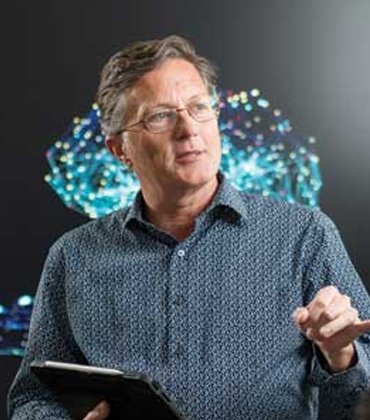
Navigating AI Trends in Educational Technology
David Bourgeois, Director of the AI Lab, Biola University

From Vision to Impact, Reimagining Learning Spaces
Robert Dillon, Director of Innovative Learning, School District of University City

Active Engagement is the Foundation of Effective Leadership
Amber Pleasant, Program Director of Adult Education and English Language Learning, Aims Community College

Virtualization as a Bridge For Multi-Campus Support
Larvell Davis, Director of Information Technology, VCU School of Pharmacy

Cultivating a Trust-Driven Technology Culture in K-12 Education
Charles Franklin, Assistant Superintendent of Technology & Information Services, Cypress-Fairbanks ISD
IN FOCUS
The New Pedagogy of Game-Based Learning
Educational technology is shifting from passive learning to immersive, game-based experiences, fostering more profound understanding, agency, and essential 21st-century skills through engaging narratives and hands-on participation.
Microlearning Meets Mobile Gaming: Bite-Sized Lessons for the Modern, Busy Learner
A shift towards microlearning and mobile gaming emphasizes bite-sized content and gamification, engaging learners and enhancing knowledge retention in today's fragmented work environments.
EDITORIAL
Empowering Learning through Innovation and Engagement
Education technology is entering a transformative era, one defined by personalization, interactivity and emotional intelligence. As traditional classrooms evolve into hybrid, digital-first environments, institutions are adopting tools that make learning inclusive and truly engaging. Gamification has emerged as a powerful force in this transformation. Interactive games and simulations are helping learners grasp complex concepts through discovery-based learning. Language apps now combine speech recognition, adaptive feedback and AI-guided progress tracking to create personalized journeys that sustain motivation. Beyond academics, social-emotional programs are nurturing empathy, self-awareness and resilience, skills vital for success in school and life. At the institutional level, intelligent management tools are improving efficiency and decision-making across the education ecosystem. Predictive analytics enhances student outcomes while automated workflows free educators from administrative burdens, creating a smarter, more connected foundation for modern education. Together, these innovations are redefining classrooms, making them more dynamic and data-informed than ever before. This edition of Education Technology Insights spotlights the top game-based learning innovators, language learning apps, AI-powered education management systems and social-emotional learning providers shaping the future of learning. It features thought leadership from Becky Vasquez, VP and chief information officer at Embry-Riddle Aeronautical University, who discusses how emerging technologies are expanding access to affordable, high-quality education. Amber Pleasant, program director of Adult Education and English Language Learning at Aims Community College, shares how empathy and active listening foster adaptable environments that empower educators and students. We hope this edition offers a fresh perspective, actionable insights and a clearer understanding of the technologies and visionaries driving education forward.
I agree We use cookies on this website to enhance your user experience. By clicking any link on this page you are giving your consent for us to set cookies. More info

However, if you would like to share the information in this article, you may use the link below:
www.educationtechnologyinsightseurope.com/edition/october-2025-20.html
